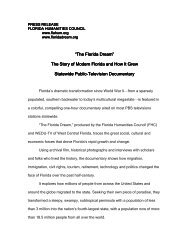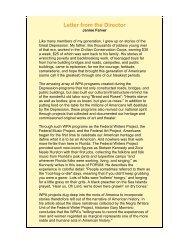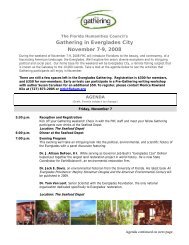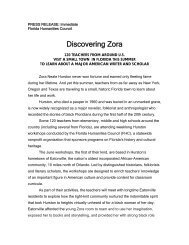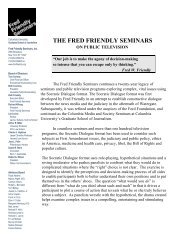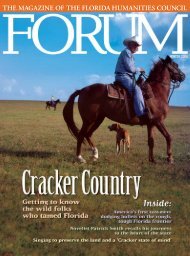when florida “Opened up the gates of hell” - Florida Humanities ...
when florida “Opened up the gates of hell” - Florida Humanities ...
when florida “Opened up the gates of hell” - Florida Humanities ...
Create successful ePaper yourself
Turn your PDF publications into a flip-book with our unique Google optimized e-Paper software.
FlOrIDA’S CUlTUrE OF SlAvErY<br />
20 F O R U M F L O R I D A H U M A N I T I E S C O U N C I L<br />
By lARRy eugene RiveRs<br />
During <strong>the</strong> 25 years leading <strong>up</strong> to <strong>the</strong> Civil War, a five-county region <strong>of</strong> North <strong>Florida</strong> grew into a<br />
virtual barony <strong>of</strong> plantations and farms that echoed <strong>the</strong> wealthiest precincts <strong>of</strong> <strong>the</strong> Old South cotton<br />
kingdom. The vast majority <strong>of</strong> <strong>Florida</strong>’s slaves lived in this central part <strong>of</strong> <strong>the</strong> Panhandle along <strong>the</strong><br />
Georgia border. Called “Middle <strong>Florida</strong>,” it centered on <strong>the</strong> capital city <strong>of</strong> Tallahassee and included<br />
Gadsden, Leon, Jefferson, Madison, and Hamilton counties—and eventually expanded into<br />
central <strong>Florida</strong>’s Alachua and Marion counties.<br />
Former slave “Uncle” Doug Ambrose is shown at <strong>the</strong> Lewis Turpentine Still and<br />
Plantation in <strong>the</strong> 1940s.<br />
Photos and Illustrations: <strong>Florida</strong> State Archives<br />
miDDLE FLoRiDA SLAvE oWnERS were pioneer<br />
entrepreneurs from Old South states who migrated to <strong>Florida</strong><br />
after it became a U.S. Territory in 1821. Many hailed from <strong>the</strong><br />
cream <strong>of</strong> Sou<strong>the</strong>rn planter society. Coming from Kentucky,<br />
Maryland, Virginia, North Carolina, South Carolina, and<br />
Georgia, <strong>the</strong>y settled on <strong>the</strong> rich, fertile land between <strong>the</strong><br />
Apalachicola and Suwannee rivers and established farms<br />
and plantations primarily to grow cotton. By 1860 this area,<br />
virtually unpopulated by whites before 1821, had emerged as<br />
<strong>the</strong> state’s plantation belt.<br />
Middle <strong>Florida</strong>’s economy was based firmly on slavery.<br />
Nearly all <strong>of</strong> <strong>the</strong> slaves (98 percent) were involved in<br />
agricultural labor. Most <strong>of</strong> <strong>the</strong>m worked on large plantations<br />
established by wealthy “planters,” an elite class composed <strong>of</strong><br />
farmers who owned at least 20 slaves and more than 500 acres.<br />
This planter class—21 percent <strong>of</strong> <strong>Florida</strong>’s slaveholders—held<br />
more than 75 percent <strong>of</strong> <strong>Florida</strong>’s slaves.<br />
The vast majority <strong>of</strong> <strong>Florida</strong>’s slaveholders ran much<br />
smaller operations. They owned small- or medium-sized farms<br />
and held fewer than 10 slaves, <strong>of</strong>ten only one or two. Usually<br />
<strong>the</strong> slaves at <strong>the</strong>se farms worked alongside <strong>the</strong>ir white owners<br />
on a variety <strong>of</strong> jobs and lived in small cabins near <strong>the</strong> main<br />
farmhouses.<br />
Slaves on <strong>the</strong> larger plantations, however, were divided<br />
<strong>up</strong> into job categories. Some worked according to a task<br />
system as carpenters, shoemakers, blacksmiths, etc. But field<br />
hands (as opposed to house servants) were sorted into work<br />
“gangs.” This “gang slavery” system, commonly associated with<br />
antebellum cotton culture, required each gang <strong>of</strong> slaves to<br />
routinely do one type <strong>of</strong> job, such as hoeing or plowing.<br />
On <strong>the</strong> most fundamental level, <strong>the</strong> degree <strong>of</strong> harshness<br />
and oppression that marked a slave’s life typically resulted



